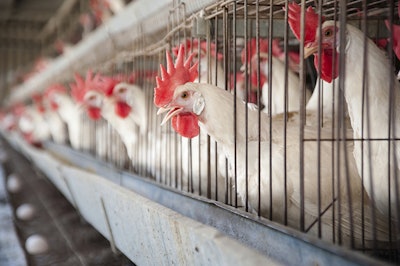
Differences in the size, location and makeup of a scratch mat appears to have little to no impact on the amount of foraging behavior demonstrated by layer hens in enriched cages, according to a new report from researchers at Scotland’s Rural College.
“I think layers are really the workhorses of agriculture,” said Dr. Victoria Sandilands, a poultry behavior and welfare scientist at Scotland’s Rural College. “My interest is to look at ways in which we can maximize the best ways to house them and manage them while still understanding that they are a production animal, and that humans benefit nutritionally from being able to eat their eggs.”
What are scratch mats?
The EU Directive on laying hens (1999/74/EC) stipulates that “laying hens must have: (c) litter such that pecking and scratching are possible.” In many cases, poultry producers provide litter as a layer’s mash – or scratch feed – on top of a plastic mat, however there is no guidance regulating the size, location or material makeup for the scratch mat.
“In the wild, chickens would spend up to 80% of their daylight hours in food seeking behavior, because it takes a long time to find enough foodstuff to fulfill metabolic and growth demands,” explained Sandilands.
“But now we're in a situation where we present hens with a highly nutritious feed right under their beaks, and they don't have to show that food seeking behavior, but the motivation is still there.”
The ability to demonstrate natural behaviors, like foraging, may also help reduce damaging behaviors like feather pecking.
In addition, scratch mats are a good place for hens to lay eggs – especially for subordinate hens or those who may not get priority access to the next boxes. Because of this, it is important that scratch mats do not compromise egg quality or cause cracks.
More about the study
The research compared four different scratch mat designs.
Only 2% of bird observations showed foraging. There was no apparent preference for any of the mat designs, but most foraging was seen after scratch feed was applied.
The hens were provided with the scratch feed at the same time as the food augers were running during this research, which may have affected the bird’s interested in foraging, Sandiland noted.
Importantly, the research revealed that most of the eggs collected from the study cages were clean and uncracked, and 89% were laid in the nest boxes. Of the small amount of cracked eggs, there was an increase in cracked eggs with one mat type only with hens that were 79 weeks of age.
“My concern had been that the sizes are all different and therefore, the amount of scratch space per hen was very different from one cage manufacturer dealer to another and was that going to be a problem in terms of fulfilling behavior,” Sandilands said. “While larger mats do allow more hens on them, the take home message from this is that out of the formats that we looked at, there was no effect of matt design on foraging behavior.”
The Scottish government provided funding for the research.
Like what you just read? Sign up now for free to receive the Poultry Future Newsletter.
















